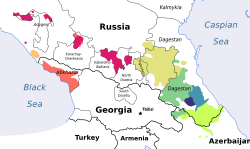|
Akhvakh language
The Akhvakh language (also spelled Axvax, Akhwakh) is a Northeast Caucasian language from the Avar–Andic branch. Ethnologue lists 210 speakers based on the 2010 census,[4] but Magomedova and Abulaeva (2007) list 20,000 speakers of the language, and the 2021 Russian census gave 7,521 speakers in Russia.[1] There are also some 1,000-2,000 speakers in Akhvakh-Dere, a village in Zagatala District, Azerbaijan.[5] It is the most divergent out of all of the Andic languages.[6] DialectsAkhvakh has several dialects, though sources do not agree on the number. Ethnologue lists Kaxib, Northern Akhvakh and Southern Akhvakh (which can be further subdivided into the Tlyanub and Tsegob subdialects).[7] Creissels (2010) lists Northern Akhvakh and three dialects of Southern Akhvakh (Cegob, Tljanub, and Ratlub). Glottolog considers the Northern and Southern dialects to be separate languages. PhonologyConsonants
As with Avar, there are competing analyses of the distinction transcribed in the table with the length sign ⟨ː⟩. Length is part of the distinction, but so is articulatory strength, so they have been analyzed as fortis and lenis.[9] The fortis affricates are long in the fricative part of the contour, e.g. [tsː] (tss), not in the stop part as in geminate affricates in languages such as Japanese and Italian [tːs] (tts). Laver (1994) analyzes e.g. t͡ɬː as a two-segment affricate–fricative sequence /t͡ɬɬ/ (/t𐞛ɬ/ = /tɬɬ/).[10] VowelsAkhvakh has a standard five-vowel system /i e a o u/ with distinctive vowel length.[9] AlphabetA few publications have been made in the Akhvakh language, such as the newspaper Zaman "Time", published since the early 1930s,[11] but for the most part speakers of Akhvakh have adopted Avar as their literary language. In the 2000s, an alphabet for Akhvakh was devised, and some publications, like the newspaper Ахвахцы — Ашвадо,[12] have been published since then. The alphabet is as follows:
GrammarAgreement classesAkhvakh has three agreement classes. In the singular, these are human masculine, human feminine, and non-human. In the plural, there are only two—human plural and non-human plural. Akhvakh verbs agree with the absolutive argument (subject of an intransitive or object of a transitive.) Consider the following examples, which show the general principles. In the first example, the intransitive verb 'run' shows feminine agreement because its subject, 'girl', is feminine. In the second example, the transitive verb 'cook' shows neuter agreement because its object, 'meat', is neuter.[13] Jaše-∅ girl-ABS q:'eɬ:-a home-LAT j-et-e FEM-run-CVB:FEM j-i:ni FEM-go:IPFV 'The girl ran home.' Ak:'o-de wife-ERG riɬ:'i meat b-iž-e N-eat-CVB:N q:'-e:ni. eat-IPFV 'The wife cooked the meat and ate it.' Note that in the second example, 'wife' is in the ergative case and appears to be the subject of both the verbs 'cook' and 'eat', but neither verb shows feminine agreement. CasesAkhvakh has an ergative-absolutive case-marking system. As the following examples (repeated from above) show, the transitive subject has the ergative case, while an intransitive subject has absolutive case. Absolutive case is not overtly marked by a suffix, but the noun phrase with absolutive case controls agreement on the verb: Jaše-∅ girl-ABS q:'eɬ:-a home-LAT j-et-e FEM-run-CVB:FEM j-i:ni FEM-go:IPFV 'The girl ran home.' Ak:'o-de wife-ERG riɬ:'i meat b-iž-e N-eat-CVB:N q:'-e:ni. eat-IPFV 'The wife cooked the meat and ate it.' In addition to the ergative and absolutive cases, Akhvakh has eighteen other cases, for a total of twenty cases.[14] The additional cases are
Notes
References
Further reading
External links
|
|||||||||||||||||||||||||||||||||||||||||||||||||||||||||||||||||||||||||||||||||||||||||||||||||||||||||||||||||||||||||||||||||||||||||||||||||||||||||||||||||||||||||||||||||||||||||||||||||||||||||||||||||||||||||||||||||||||||||||||||||||||||||||||||||||||||||



